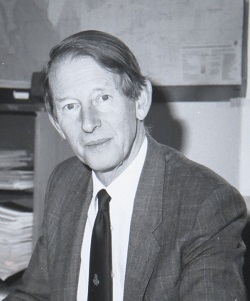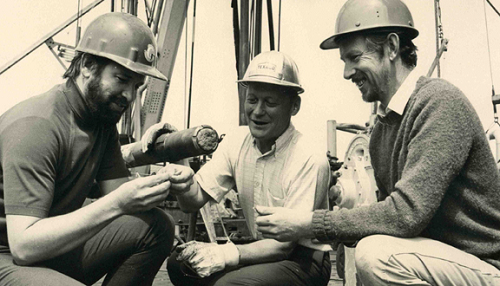 Former Director of the Institute of Oceanographic Sciences who received a Knighthood for Services to Oceanography
Former Director of the Institute of Oceanographic Sciences who received a Knighthood for Services to Oceanography
Sir Anthony Laughton, or Tony as he was known to his many colleagues, died on 27th September at the age of 92 after a short illness.
His career in marine geophysics spanned the immediate post-war period to well into the 21st century. He rose to become Director of the Institute of Oceanographic Sciences from which he retired in 1988. He was a warm and approachable man who could charm, but also someone who could be tenacious in the pursuit of what he thought was right.
(Image: IOS negative 7850-4)
National Institute of Oceanography
Tony graduated from Cambridge University in 1951 with an honours degree in Natural Sciences and became a research student of Maurice Hill in Cambridge’s fledgling marine geophysics group. Tony was recruited by Dr (later Sir) George Deacon, founder Director of the National Institute of Oceanography (NIO) in Wormley, Surrey.
In those days NIO scientists had free rein and Tony decided to build a deep-sea camera. Within a year he was able to take photos of the sea-floor, some in colour, in depths down to 4800m. On the same cruise he became interested in using the echo-sounder to map the sea-floor and this was to have a lasting impact on him. A new, NIO-designed precision echo-sounder, which could measure depths to within one fathom, was trialled in 1958. Tony’s interest in sea-floor bathymetry continued for the rest of his life.
The International Indian Ocean Expedition took place in 1962-1963 with UK scientists on board the brand new RRS Discovery. A major three-month geological/geophysical cruise in 1963, led by Maurice Hill from Cambridge and in which Tony participated, offered new directions for his research. In particular, he began to consider how the geological development of the Gulf of Aden related to the history of the mid-ocean spreading Carlsberg Ridge. The eventual result was the publication of seminal bathymetric and magnetic anomaly charts of the Gulf, which helped to tie in the history of the Red Sea with that of the northwest Indian Ocean.
In 1969 an in-house designed, towed side-scan sonar instrument (GLORIA, or Geological LOng-Range Inclined Asdic) was used for the first time in open Atlantic conditions in a cruise led by Tony. Although useful data were collected, the launching and recovery operations proved to be hazardous at times and required good weather. One early serendipitous success was the discovery that the transform plate boundary between Gibraltar and the Azores was expressed on the sea floor as a single linear fault, over 400km long towards its western end. Other surveys of the Mid-Atlantic Ridge followed, some using the vastly improved GLORIA Mk II which could survey 1100 square kilometres per hour.
The Deep-Sea Drilling Project
 Image: Tony Laughton examining a core on board DV Glomar Challenger with Bill Berggren (left) and Bill Allinder, Cruise Operations Manager, during Deep Sea Drilling Project Leg 12 in 1970. [copyright British Library]
Image: Tony Laughton examining a core on board DV Glomar Challenger with Bill Berggren (left) and Bill Allinder, Cruise Operations Manager, during Deep Sea Drilling Project Leg 12 in 1970. [copyright British Library]
The Deep-Sea Drilling Project (DSDP) appointed Tony as one of the two Co-Chief Scientists for DSDP Leg 12 with Bill Berggren, a micropalaeontologist from Woods Hole Oceanographic Institution. Bill was a species of Earth scientist that Tony had probably not encountered hitherto but the two got on very well. The expedition drilled nine sites in the Labrador Sea, Reykjanes Ridge, Rockall Bank and the Bay of Biscay. Tony’s involvement and interest in DSDP, and its subsequent incarnations, continued for many years afterwards.
DSDP Leg 12 caused Tony to re-focus on areas nearer to home and led to publication between 1975 and 1983 of an important and widely used series of five bathymetric charts of the NE Atlantic at the scale of 1:2.4 million. At about this time Tony’s contribution to the General Bathymetric Chart of the Oceans (GEBCO), in which he had been involved since 1966, increased. Through his membership of an Intergovernmental Oceanographic Commission (IOC) scientific working group he was invited to join GEBCO’s Guiding Committee at a crucial time when the specifications for GEBCO’s new 5th Edition charts were being formulated. These charts were eventually used in labs the world over.
In 1986 Tony became Chairman of GEBCO’s Guiding Committee in which role he continued until the Centenary of GEBCO in 2003. Subsequently he, with others, succeeded in setting up a GEBCO training programme in undersea mapping funded by the Nippon Foundation at the University of New Hampshire. This programme is now in its 16th year and trains around six international students each year.
Tony Laughton became Director of the Institute of Oceanographic Sciences (IOS), formerly NIO, in 1978. Subsequently he oversaw eight years of GLORIA surveys of the whole Exclusive Economic Zone of the USA. This project was managed by Tony Rees and for its work with GLORIA, IOS was awarded the Queen’s Award for Industry. Around 1980 there was a major influx of new staff to IOS, which included the thriving geophysics group now led by Tim Francis, to set up a research programme funded by the Department of the Environment to study the feasibility of disposing high-level radioactive waste at sea.
Honours
Tony received many awards in his long career. In 1980 he became a Fellow of the Royal Society and he was awarded a knighthood in the Queen’s birthday honours of June 1987 for ‘Services to oceanography’. To his great delight he was awarded an honorary DSc degree by the University of Southampton in July 2019.
Tony had interests beyond science which included music - he played French horn in two orchestras for many years - dinghy sailing, gardening and woodwork. In latter years he was a regular tennis player. He leaves his wife Clare and their daughters Rebecca and Susanna, Andrew his son from his first marriage, and three grandchildren.
By Bob Whitmarsh
This obituary is a shortened version of one that first appeared in Ocean Challenge: Whitmarsh, R.B., 2020. Sir Anthony Laughton DSc, FRS (1927-2019). A tribute to a leading light of UK oceanography. Ocean Challenge, Vol. 24, No.1, 6-7.